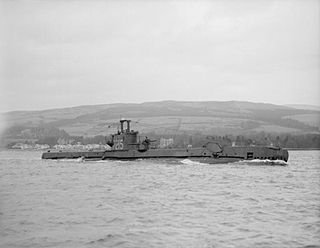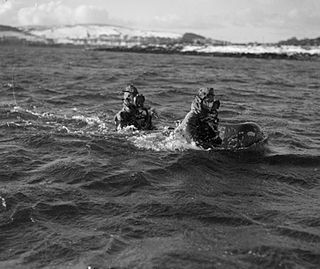
The submarine film is a subgenre of war film in which the majority of the plot revolves around a submarine below the ocean's surface. Films of this subgenre typically focus on a small but determined crew of submariners battling against enemy submarines or submarine-hunter ships, or against other problems ranging from disputes amongst the crew, threats of mutiny, life-threatening mechanical breakdowns, or the daily difficulties of living on a submarine.

A midget submarine is any submarine under 150 tons, typically operated by a crew of one or two but sometimes up to six or nine, with little or no on-board living accommodation. They normally work with mother ships, from which they are launched and recovered and which provide living accommodation for the crew and support staff.

HMS Sceptre (P215) was a third-batch S-class submarine built for the Royal Navy during World War II. Completed in April 1943, she spent the majority of her career in the North Sea, off Norway. After an uneventful patrol, the submarine participated in Operation Source, an attack on German battleships in Norway using small midget submarines to penetrate their anchorages and place explosive charges. However, the midget submarine that she was assigned to tow experienced technical difficulties and the mission was aborted. During her next four patrols, Sceptre attacked several ships, but only succeeded in severely damaging one. She was then ordered to tow the submarine X24, which was to attack a floating dry dock in Bergen. The operation, codenamed Guidance, encountered difficulties with the attacking submarine's charts, and the explosives were laid on a merchant ship close to the dock instead. The dock was damaged and the ship sunk, and X24 was towed back to England. Sceptre then conducted a patrol in the Bay of Biscay, sinking two German merchant ships, before being reassigned to tow X24 to Bergen again. The operation was a success, and the dry dock was sunk.

Human torpedoes or manned torpedoes are a type of diver propulsion vehicle on which the diver rides, generally in a seated position behind a fairing. They were used as secret naval weapons in World War II. The basic concept is still in use.

The X class was a World War II midget submarine class built for the Royal Navy during 1943–44. It was substantially larger than the original Chariot manned torpedo.

Commander Donald Cameron, VC was a Scottish sailor and a recipient of the Victoria Cross, the highest award for gallantry in the face of the enemy that can be awarded to British and Commonwealth forces. He is one of three VC recipients from the small town of Carluke in South Lanarkshire. The Rotary Club of Carluke have erected a millennium stone in the town market place to commemorate this.

Rear Admiral Basil Charles Godfrey Place,, known as Godfrey Place, was an officer in the Royal Navy and a recipient of the Victoria Cross, the highest award for gallantry in the face of the enemy that can be awarded to British and Commonwealth forces.

The Cruel Sea is a 1953 British war film based on the novel of the same title by Nicholas Monsarrat. The film starred Jack Hawkins, Donald Sinden, Denholm Elliott, Stanley Baker, Liam Redmond, Virginia McKenna and Moira Lister. The movie was made by Ealing Studios seven years after the end of the Second World War, and was directed by Charles Frend and produced by Leslie Norman.

Britain's commando frogman force is now the Special Boat Service (SBS), whose members are drawn largely from the Royal Marines. They perform various operations on land as well as in the water. Until the late 1990s, all members of the Special Air Service (SAS) Boat Troop were trained as commando frogmen.

Operation Source was a series of attacks to neutralise the heavy German warships – Tirpitz, Scharnhorst and Lützow – based in northern Norway, using X-class midget submarines.

Operation Tungsten was a Second World War Royal Navy air raid that targeted the German battleship Tirpitz. The operation sought to damage or destroy Tirpitz at her base in Kaafjord in the far north of Norway before she could become fully operational again following a period of repairs.

The Welman submarine was a Second World War one-man British midget submarine developed by the Special Operations Executive. It only saw action once and was not particularly successful.

HMS Sea Nymph was a S-class submarine of the third batch built for the Royal Navy during World War II. Completed in July 1942, she spent the majority of her career patrolling the waters off Norway in the North Sea, then was sent to the Pacific but was forced back due to technical problems.

Vice-Admiral Sir Arthur Richard Hezlet, nicknamed Baldy Hezlet, was a decorated Royal Navy submariner. He became the Royal Navy's youngest captain at the time – aged 36 – and its youngest admiral, aged 45. In retirement he became a military historian.

Hecht, also known as Type XXVIIA, was a two-man all-electric German midget submarine created during World War II.

Submarine X-1 is a 1968 British war film loosely based on the Operation Source attack on the German battleship Tirpitz in 1943. In the film, James Caan stars as Lt. Commander Richard Bolton, a Canadian, who must lead a group of midget submarines in an attack on a German battleship.

The Chariot was a British manned torpedo used in World War II. The Chariot was inspired by the operations of Italian naval commandos, in particular the raid on 19 December 1941 by members of the Decima Flottiglia MAS who rode "Maiali" manned torpedoes into the port of Alexandria and there placed limpet mines on or near the battleships HMS Valiant and HMS Queen Elizabeth as well as an 8,000-ton tanker, causing serious damage which put both battleships out of operational use until 1943.
Lieutenant Charles Esme Thornton Warren MBE (1912–1988) was a bestselling British author, a Second World War Royal Navy submariner, and one of the first Allied 'human torpedo charioteers', practising methods of clandestine attack upon enemy harbours and ships.
Captain William Richmond Fell, was a New Zealand naval officer. He served in the Royal Navy, mainly in submarines, and was involved in the development of human torpedoes and midget submarines during the Second World War.

Operation Title was an unsuccessful Allied attack on the German battleship Tirpitz during World War II. It involved two British Chariot manned torpedos that were transported close to the battleship's anchorage in Trondheimsfjorden, Norway, by a Norwegian-crewed boat between 26 and 31 October 1942. The attack was abandoned following the accidental loss of both Chariots in the evening of 31 October.


















